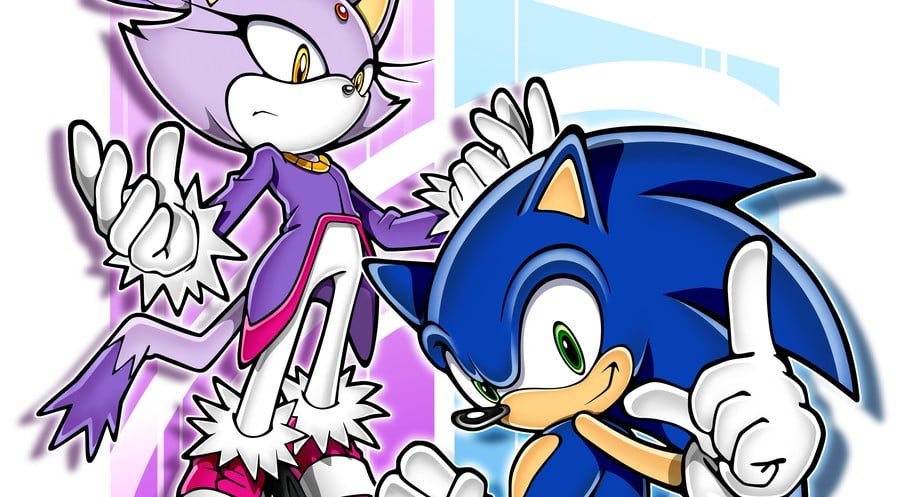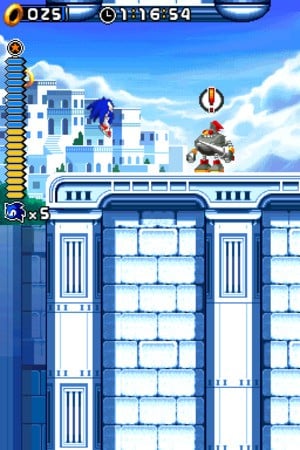
As part of our end-of-year celebrations, we're digging into the archives to pick out some of the best Time Extension content from the past year. You can check out our other republished content here. Enjoy!
Sonic has always been cool. Say what you will about the fanbase, what with its full-size Sally Acorn models with complete skeletal structures and such, but Sonic himself epitomises radness. Unfortunately, while he maintained his cool as a character, there came a point in time when Sonic games started to be seen as the exact opposite. Efforts such as Sonic Adventure DX Director’s Cut and Sonic Heroes didn’t exactly set the world on fire, while Shadow the Hedgehog represented a kind of franchise nadir, marketed around Shadow packing heat and using transgressive language such as “damn”. Things seemed a little bleak for our hero.
But then came Sonic Rush, a title few had paid attention to in the lead-up to its release. It was a new handheld Sonic, and they were a dime a dozen at the time with the Sonic Advance trilogy, Sonic Adventure 2: Battle and Sonic Pinball Party. But Rush was different; Rush was new. This unassuming handheld spin-off was ultimately so influential that it changed the core gameplay of the main series. And best of all? This game was cool as hell.

A lot of Sonic Rush’s aesthetic was, admittedly, borrowed to some extent from the vibe of cult Dreamcast hit Jet Set Radio; with Hideki Naganuma on soundtrack duty, the game oozed style out of its electronic pores. Sonic had a new move, one that would come to be very familiar. With a quick tap of the Y button, Sonic would boost forward at a tremendous speed – from zero to Mach 1, basically – destroying anything in his path. The catch was that the 'Boost' bar had to be filled by destroying enemies, collecting items or performing tricks.
Yes, tricks – in another tremendous stylish touch, tapping the B and R buttons in certain situations (bouncing from springs, grinding rails etc) made Sonic pop and lock in midair, showing off to the player. The more sequential tricks you performed, the more points you’d receive and the higher your grade was at the end of the stage. Busting out a particularly fierce set of moves would have Sonic’s animal friends leap up from the bottom of the screen, acting as cheerleaders, thrilled by his (and your) performance.
The story of the game revolves around the introduction of Blaze the Cat, who helps the proceedings by being one of the best of Sonic’s many friends. Cool, calm and collected – but prone to, well, blazing anger – Blaze was a breath of fresh air compared to some of Sonic’s other personality-free hangers-on. Oh, and she danced, too; on the post-level results screen, she’d twirl into position as Naganuma’s “Original Groove Rush” accompanied her. Sounds goofy. It’s not. Sonic does the same – all of a sudden he’s getting fresh over his A rank, set to another absolute bop.
Boss battles, too, have a sense of rhythm to them. While they’re not the strongest part of the overall package, they are formidable 3D cel-shaded beasties that still impress today thanks to the heavily stylised models. Dynamic camera moves add a new dimension to their attacks, with the first boss flipping the sidescrolling view in order to roll towards the player, making for additional drama. Each boss fight has you accompanied on the bottom screen by either Miles “Tails” Prower or Cream the Rabbit, each of whom will cheer on Sonic or Blaze respectively in a way that’s genuinely rather sweet and entirely welcome. The excitement is further laid on thanks to Naganuma’s absolutely superb Metal Scratchin’ boss theme, which of course escalates as the battle continues.

Let’s talk about that soundtrack a little. To this day it’s quite unlike any other Sonic game’s music, and we’re at a loss as to why, given how absolutely successful it is. The direct sequel Sonic Rush Adventure tries to continue along the same lines, but it just doesn’t have the oomph of its predecessor. Here, though – to use the parlance of “the kids” – it slaps. Naganuma’s tracks are bangers through and through, from the shortest snippets to accompany menus to the absolutely epic “Wrapped in Black” tune that accompanies the final boss with a Malcolm X sample, of all things. Along the way you’ll enjoy the likes of Jeh Jeh Rocket, What U Need and the iconic New Day. It ain’t standard Sonic fare, but it’ll make you want to break out your headphones.
The core skill needed to maximise your enjoyment of Sonic Rush is that of keeping your Boost bar full, achieved by maintaining an efficient path through each stage defeating enemies and collecting items enough to keep the bar constantly in its red (full) state, utilising tricks on every spring, every cannon, every grind rail. It’s a delicate and thoroughly difficult dance, keeping Sonic or Blaze moving and tricking with the maximum possible skill. Of course, this manner of showing-off can be brought to a humiliating end by taking a hit from any of the various enemies scattered around the stages, causing you to lose all your rings (of course) and, worse yet, see your Boost bar bottom out at zero. Skilled players will be able to keep on boosting and shave seconds off their level clear times to aim for that elusive S rank, but it’ll take a long time (and a lot of swearing) to reach that level of skill.
Sonic Rush’s basic gameplay philosophy made its way to the “mainline” 3D series with Sonic Unleashed, and Boost has been a continued presence in the series since, showing up in Sonic Colors and Sonic Forces. It’s a testament to Rush’s quality that essentially nothing else from Sonic’s handheld adventures made the cut for the big leagues, except Blaze the Cat and the Boost system. It’s a little unfortunate that the aforementioned games struggled to apply the same skilful level design that Rush brought to the table, but Sonic fans manage to use Boost to effectively reformat each stage as they please – a testament to their creativity, yes, but also to the philosophy of the Boost system; gotta go fast, if you will.






Comments 4
Both Sonic Rush games are amazing. During the height of the 3DS I really hoped for a 3rd entry.
The focus on speed was Sonic at it's best.
Was only playing that last night and while I do like the game the amount of bottomless pits and instant kill traps really puts me off going back to it compared to other Sonic games. Then you have the Special Stages and tbh I have no idea what the developers were smoking when they made the 6th and 7th one but it had the worst level design I have ever seen.
The sonic rivals games were overlooked too, they're sort of the psp equivalent, despite being a different genre.
While I do love the Sonic Rush and Advance games, those aren't really out performing the Genesis classics. They focus too much on speed yes but the way some of the levels are design just made for questionable decisions. Also way too many bottomless pits and too many unnecessary collectibles for un-interesting reward just aren't worth it. They are still fun to try and play to kill time with but that's it. They are above the Sega CD, 32X, Sega Saturn, Game Gear, 3DS, Wii, PS3, PS4, PSP, mobile, and NeoGeo Pocket Color Sonic games but came nowhere close to Sonic Mania or any of the four Sega Genesis titles in terms of level design, fun factor, secrets, rewards, and story set.
Show Comments
Leave A Comment
Hold on there, you need to login to post a comment...